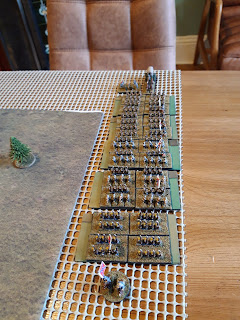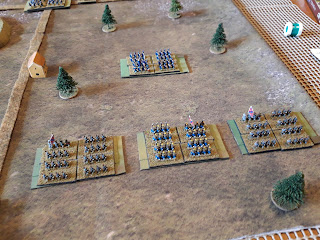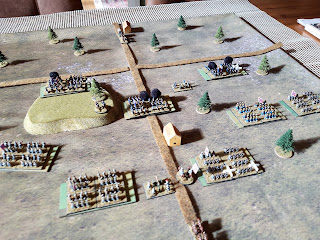Having scratched my Ancient gaming itch with the 3x3 experiments, I was still unhappy with my ACW gaming efforts. I think the ACW variant of Rifle and Kepi has the most legs, but it takes a fair bit of work to set the scenarios up and I'm really not sure I can be bothered to do that every time.
I have been very taken with http://hereticalgaming.blogspot.com/ and his project to fight through a load of One Hour Wargames scenarios using Simplicity in Practice. I've played SiP before and I think it needs a lot of work to be a passable ACW game, but I was a bit baffled to find no mention of the ACW in Neil Thomas's Nineteenth Century Warfare rules which I've also got. I was sure I'd read some of his ACW rules somewhere, then it came to me, there was a set in his Introduction to Wargaming book.
They are a pretty basic set, and include some very similar mechanisms to both SiP and the Nineteenth Century rules, but with some ACW specific tweaks. I particularly liked the propensity of units to run away and reorganise rather than just stand there and lose lots of bases, as well as the random unit quality which varies by year.
Time to break out some toys. I went with OHW Scenario 27 'Disordered Defence' which is based on Shiloh in 1862, but played with the ACW rules from Into to Wargaming.
Battlefield from the south. The terrain is pretty abstracted compared to the real battle, but I added in the extra hill near the Hamburg-Savannah road junction and scattered trees around as the terrain was heavily wooded. Shiloh Church is in the foreground and the deployed units represent the elements of Grants army caught by surprise by Johnstones attack. Sherman on the left, Prentiss on the right and Hurlbut back on the crossroads with an artillery piece. Prentiss's division was Green while the other two were Seasoned. irl there were other units in the area, but these appear later on.
The Tennessee river is off to the north along with Grants base at Pittsburgh Landing. Having painted some wagons I thought I may as well put some on even though they have no effect. As the movement distances are so short (8cm for infantry), I played this on a 2' x 2' table. not a 3x3.
Half the Union Army is offtable, 1st and 3rd Divs, plus two more divisions from the Army of the Ohio plus more artillery. These chaps will enter from the north on turn 8. Historically the Union scrambled to throw units into the fight.
Johnstones Army of the Mississippi. Five Corps/Divisions and some guns. Hardees Corps was Veteran, I Corps and Reserve Corps were Seasoned while Ruggles and Withers were Green. These all set up a few inches from the southern edge.
Ruggles and I Corps face off against Sherman, supported by the gun. The only major change I made to the original scenario was to limit maximum visibility to 16cm (rifle range) due to the woods. This mainly inconvenienced the artillery, but they are massively underpowered in these rules (1 dice each!).
Reserve Corps, Hardee and Withers face Prentiss. The Confederates need to capture the crossroads and hold it at the end of the game, It is a race against time to take it before the Union reinforcements arrive.
The Confederates go first and withering fire inflicts eight hits (!) on Sherman. He loses two bases (I just marked them with puffs of black smoke) and had to take two morale tests. In these rules, each failure results in a retreat, so having failed both, he legged it back to the road.
On the other flank, Prentiss took eleven hits! Well, these are certainly quite bloody. They also ran away. Historically Hardee overran Prentiss early on.
There didn't seem much point advancing back onto the inferno, so both Sherman and Prentiss tried and failed to rally. Rallying is only allowed out of small arms range, and recovers a base if successful. Hulburt and the artillery moved up to Shiloh Church.
The entire Confederate line rolled forwards, very, very slowly as movement is only 8cm. No interpenetration is allowed either so I left gaps between units in case they needed to wheel (which reduces their movement to 4cm!).
Hurlbut put a couple of hits onto Res Corps but not enough to remove a base.
The centre of the Confederate Army halted and gave Hurlbut a volley, inflicting eight hits (two bases lost). The flanks advanced. At least Sherman managed to rally a hit off. Hurlbut failed one morale test and retreated.
The Confederate advance resumed on the left and centre. Just visible on the right is Prentiss division being blown to pieces. Four bases lost and unit destroyed. Johnstone set up his HQ next to the church. Leaders have no role in these rules, but I've painted them so...
Sherman put a couple of hits on Ruggles. Infantry get one dice per active base, so three shots in this case , unlike SiP where they always fire four dice.
The rest of the Confederates pushed up to and beyond the Church. Res Corps had lost a base by now. At this point I swapped the big white hit markers for little dice as they were less obtrusive. It is a bit confusing keeping track of two kinds of hits, but I don't like taking bases off, too much stuff to sort out when it needs putting away. Over on the far right Withers pushed right forwards.
A hail of fire landed on the Union centre. The artillery was knocked out and Hurlbut reduced to a single base. Rather annoyingly he passed his morale test instead of sensibly running away.
Hardee and Withers wheeled inwards. Pivot on the centre but only 4cm of movement allowed. Clearly fancy manouvres are not encouraged.
I Corps joins Ruggles in a very close range firefight against Sherman. Now both sides are a bit weaker, the rate of losses has fallen.
I Corps goes in with the bayonet. Unlike the nineteenth century set where charging is based on relative advantage in hits, in these rules units have to make a morale test to charge frontally and it is quite hard. I Corps rolled a six though.
The Confederate fire demolishes Hurlbut on the crossroads and Hardee and Withers close in.
The assault on the hill is bloody but hilariously indecisive. The winner of close combat has to retreat, but it was a draw! In fact charging was a really stupid idea as it blocked Ruggles fire and just resulted in I Corps taking losses from defensive fire. It would have been better to just shoot but I wanted to push Sherman back.
The Union reinforcements arrive, much to Grants relief. They can't use road movement as this is disallowed within 24cm of the enemy, so they inch on a mere 8cm. As rifle range is 16cm, that brings the crossroads under fire.
Hardee and Withers cross the turnpike. They still haven't physically managed to take the crossroads yet.
There is now a bit of a traffic jam ahead so Res Corps stops to rally instead and manages to recover a base. I do like this simple approach to traffic management, funny how easy it is to get in a jam.
Hilariously the close combat is another draw, but losses have now reached such a point that both sides lose a base and both fail their morale and fall back. That was a slightly unlikely result. Normally the loser would fall back and the winner is immune to morale tests.
The stationary Union troops open a withering fire on the Confederates, but only Hardee actually loses a base. I Corps moves back up to the hill.
Sherman is finally routed however. Not quite sure how I Corps managed to rally there, maybe I've missed a turn.
The gun slips in between Hardee and Withers, allowing Res Corps to move up. The Confederates fire is absolutely devasating as the Union troops can't retreat (too close to the table edge) so every morale failure results in another base lost. tbh, I'd probably just let them retreat off in future.
Hardee loses another base and retreats, but the rest of the Confederate army is in line now and blazing away. I can do Lanchester calculations as well as anyone and I think this is only going to go one way.
I won't bore you with several pictures of static units shooting at each other. Suffice to say that the Confederates started with a dice advantage (20 vs 17) and as they progressively weakened the Union their relative advantage just grew. By this stage their advantage is 16:10.
By the last turn it was at 18:1! I don't think the Union are going to retake the crossroads. Johnstone has indeed 'hammered them' as he promised to do.
That was actually very enjoyable, and I liked playing on the 2x2 table. As with all NT rules, there were some (many) vague bits, but overall it hung together well. I liked the running away and rallying, and the truely devastating firepower. I found the tiny move distances a bit limiting though, made worse by the wheeling restriction, and I'd prefer a role for leaders in the game. There are no situational modifiers for close combat at all, apart from it being easier to assault from a flank, so I'm not really sure how well that works. The low dice artillery worked OK, as sometimes that extra dice was enough to make up to a full base lost, but they do seem terribly underpowered compared to his other rules.
If I was going to make changes, I'd probably increase the movement distances to be a bit closer to SIP and convert all the distances to inches as I found cm too fiddly. Anyway, that was an interesting experiment and quite fun. From a play balance pov I must remember that on average the Confederate troops are better than the Union, and adjust the number of units accordingly. I'll have a bit of a think and make some modifications.
I wanted to run bit of a campaign to try out various rules iterations, so I had a look through Frank Chadwicks 'Battles of the Amercan Civil War' and picked out some OHW scenarios which mapped roughly onto their real life counterparts. They are all from the western campaign as I'm thinking about how best to approach Gettysburg, but these will give a spread of years so troop quality will improve and the last one even features some fortifications. So we have:
Shiloh 1862 - Scenario 27 Disordered Defence. USA (Red), CSA (Blue)
Stones River 1863 - Scenario 3 Control the River. USA (Blue), CSA (Red). You could do Pitched Battle for this one instead
Bakers Creek/Champion Hill 1863 - Scenario 7 Flank Attack. CSA (Red), USA (Blue)
Chickamauga 1863 - Scenario 5 Bridgehead. USA (Red), CSA (Blue). This one will have restricted visibility like Shiloh as it was heavily wooded.
Franklin 1864 - Scenario 21 Twin Objectives. USA (Red), CSA (Blue). For this one I will borrow the dug-in and barrage mechanism from the Machine Age rules as Franklin was fortified.
































Looks like you had fun Martin. Shiloh is an interesting battle and quite spread out- good to see it reduced down so successfully.
ReplyDeleteCheers,
Pete.
Yes, I thought the scenario was rather good (it is certainly a lot easier to play than the Volley and Bayonet one!).
DeleteHey Martin,
ReplyDeleteAs you mention, the tie breaker in these WAI: ACW rules is Defender loses [after all, Attacker passed a Morale Check just to charge, so are committed]. The winner of HtH does not have to check morale for a Base loss.
Guns get two dice at closer ranges, or a re-roll for the parrot.
I also wondered what I gained by melee instead of shooting. The way I handle it is that a successful close combat SHOULD be decisive, and take ground. So the melee loser checks morale, and if fail end facing AWAY from the melee. If they pass, they face the enemy.
I think the contrast between the Naps and ACW rules in WAI is a great example of a successful design concept - one may not agree with the concept, but he makes a great case for it. It just needs to be developed a bit better.
Overall, the W19CE rules are better developed, altho there are a lot of little mechanics to work out, as my time with Franco-Prussian War has shown!
I hope to use my FPW spin on them for ACW. I will probably make it that Fire has you Fall Back a half move facing the enemy, and Melee has you Retreat a full move facing away from the enemy, or something like that.
Best, Alex
Thanks Alex, I was impressed with these rules and I think I made a few mistakes as I was applying some of C19 and Napoleonic mechanisms and I'd missed the thing about draws in melee. I agree that melee results should be decisive.
DeleteI'm not a huge fan of re rolls, so I just said that Parrots hit on a 3+ (the probability is virtually identical to a 4+ reroll) which brings it into line with Simplicity in Practice.
I'll play around a bit with the artillery values. The thing I'm struggling with the most is working out to balance out the unit strengths using the variable unit quality rolls (a concept really like for this particular conflict).